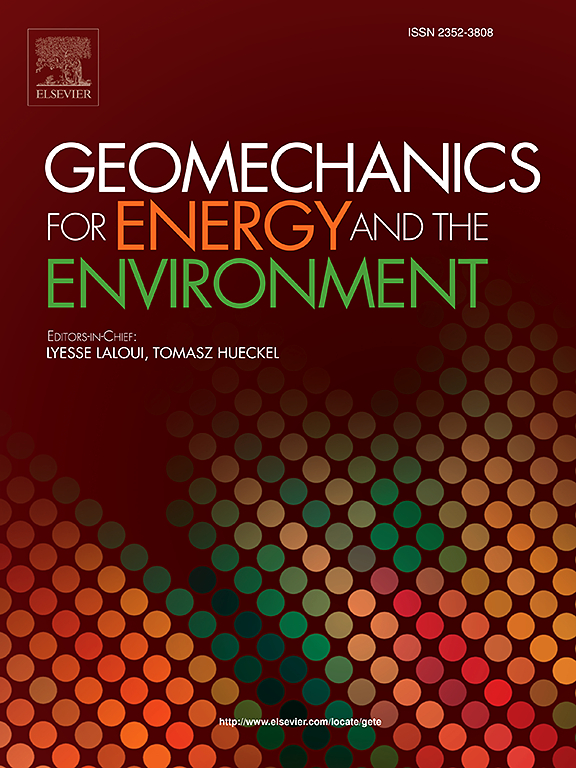低渗透走滑断层上注入地震的成核
IF 3.7
2区 工程技术
Q3 ENERGY & FUELS
引用次数: 0
摘要
向地下地层注入流体可能引起破坏性地震,并增加注入点对远程触发的敏感性。如果断层的本构行为和地质力学条件允许摩擦不稳定的发展,滑动可能最终加速并触发同震滑动事件。我们研究了控制诱发地震前的滑动不稳定性的摩擦和流体力学机制,即成核阶段。了解断层再活化和从准静态地震滑动到动态破裂的转变是一个重要的目标,因为成核阶段可能为探测震前信号和估计地震震级提供关键。我们的模拟表明,孔隙弹性耦合延迟了滑动和动态破裂的发生,并在断层上造成了不对称的滑动和压力分布。我们的研究结果表明,压力驱动的成核模式虽然在性质上与弹性介质中的构造地震相似,但受流动过程和孔隙弹性耦合的控制,有利于成核带的扩展。我们的数值结果表明,诱导事件的成核长度L与经典标度L∞=b(b−a)2G ‘ dcσ n ’成核时间与L2成核成核时间成正比。此外,由于τnuc ~ L2和L ~ L∞,则τnuc ~ L∞2。成核阶段越长,在动态破裂开始时孔隙压力越大,断层越弱。本文章由计算机程序翻译,如有差异,请以英文原文为准。
The nucleation of injection-induced earthquakes on low-permeability strike-slip faults
The injection of fluids into underground formations may induce damaging earthquakes and increase the sensitivity of injection sites to remote triggering. If the fault constitutive behavior and geomechanical conditions permit the development of a frictional instability, slip may eventually accelerate and trigger a coseismic slip event. We investigate the frictional and hydromechanical mechanisms that control the slip instability preceding an induced earthquake, the nucleation phase. Understanding fault reactivation and the transition from quasi-static aseismic slip to dynamic rupture is an important objective, as the nucleation phase may provide the key to detect preseismic signals and estimate the magnitude of the resulting earthquake. Our simulations show that poroelasticity coupling delays the onset of slip and dynamic rupture and creates asymmetric slip and pressure distributions on the fault. Our results indicate that pressure-driven nucleation patterns, while qualitatively similar to those of tectonic earthquakes in elastic media, are controlled by flow processes and poroelastic couplings that favor nucleation-zone expansion. Our numerical results suggest that nucleation lengths for induced events scale proportional to the classical scaling and time to nucleation with . Moreover, since and , then . A longer nucleation phase leads to higher pore pressures and a weaker fault at the onset of dynamic rupture.
求助全文
通过发布文献求助,成功后即可免费获取论文全文。
去求助
来源期刊

Geomechanics for Energy and the Environment
Earth and Planetary Sciences-Geotechnical Engineering and Engineering Geology
CiteScore
5.90
自引率
11.80%
发文量
87
期刊介绍:
The aim of the Journal is to publish research results of the highest quality and of lasting importance on the subject of geomechanics, with the focus on applications to geological energy production and storage, and the interaction of soils and rocks with the natural and engineered environment. Special attention is given to concepts and developments of new energy geotechnologies that comprise intrinsic mechanisms protecting the environment against a potential engineering induced damage, hence warranting sustainable usage of energy resources.
The scope of the journal is broad, including fundamental concepts in geomechanics and mechanics of porous media, the experiments and analysis of novel phenomena and applications. Of special interest are issues resulting from coupling of particular physics, chemistry and biology of external forcings, as well as of pore fluid/gas and minerals to the solid mechanics of the medium skeleton and pore fluid mechanics. The multi-scale and inter-scale interactions between the phenomena and the behavior representations are also of particular interest. Contributions to general theoretical approach to these issues, but of potential reference to geomechanics in its context of energy and the environment are also most welcome.
 求助内容:
求助内容: 应助结果提醒方式:
应助结果提醒方式:


